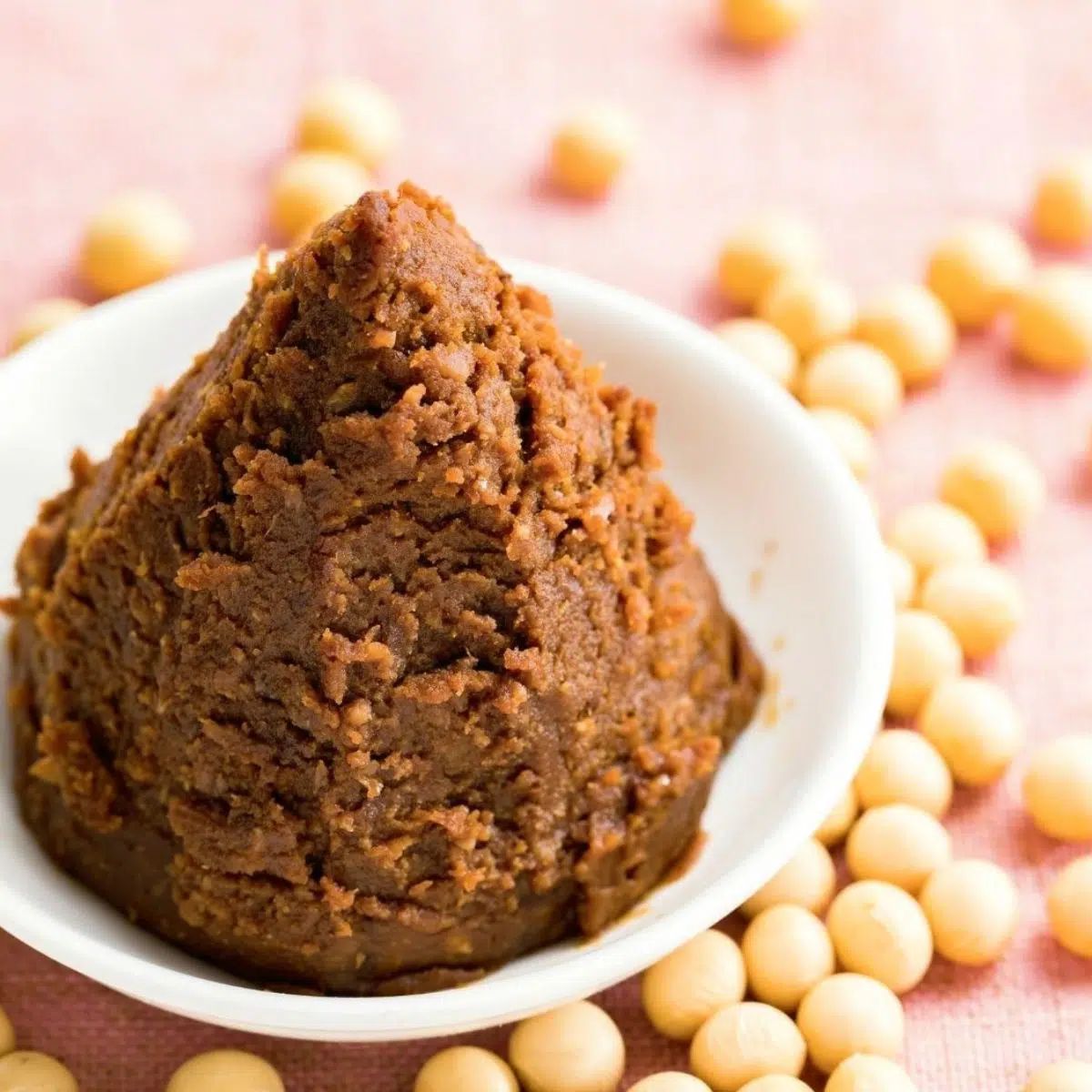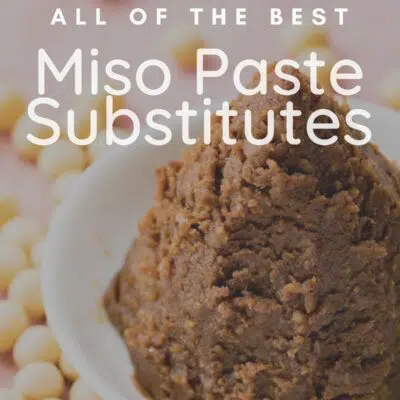You may find yourself in need of a miso paste substitute if you like to dabble in Asian and Asian-inspired cooking. Miso paste can be found in soups, sauces, glazes, batters, and dressings, so you never know when a replacement for miso could come in handy!
Best Miso Paste Substitutes
The umami taste of Asian cuisine is popularly associated with soy sauce. However, it is not soy sauce but what soy sauce is made from that provides that flavor.
The umami flavor comes from fermented soybeans. In addition to soy sauce, there are a handful of other Asian condiments that share a similar flavor. Miso paste is one of them.

Jump to:
What is Miso Paste?
A staple in Japanese cuisine, miso paste is made from fermented soybeans. In addition to the soybeans, other ingredients such as grain and mold are added during the fermentation process.
While the idea of mold in your food may not sound appetizing, this is a special mold called Koji. Koji helps along the fermentation process and is perfectly safe to eat. In fact, you may have already enjoyed it before as it is also used to make sake.
The rich and complex flavors of miso paste are extremely versatile. It is commonly used to enrich the umami flavors in broths, soups, sauces, and stir-fries. Beyond just adding a well-balanced savory and salty flavor to dishes, it is also used to add texture to certain recipes. It can even be used to make chocolate chip cookies!
Substitutes for Miso Paste in Cooking
One reason you may need a miso paste substitute is because of a new recipe you found. If you have never tried the recipe before, I encourage you to try it first with miso paste to see what the intended flavor and texture are meant to be.
If you are not quite ready to invest in miso paste though, or you already love it and just ran out, reach for one of these easy substitutes.
As you search for the perfect substitute, make sure to consider what the purpose of the miso paste is in your recipe. Certain substitutes will be better for flavor, while others will be better for texture. To get the best of both sides you may need to combine two different substitutes.
1. Soy Sauce
Soy sauce is the easiest substitute for miso paste because it is the most common one to have at home. While soy sauce is also made from fermented soybeans, it is a simpler flavor. It is also saltier than miso paste.
Soy sauce will work well in recipes that use miso paste for the salty umami flavor. However, since it is a liquid (and not a paste) it will not work as a substitute in recipes that rely on miso paste for a specific consistency or texture.
Use soy sauce as a substitute for miso paste in sauces, stir-fries, marinades, and soups. In most recipes, a 1:1 ratio will be great. Due to the different consistency and added saltiness though, I recommend starting with half the amount of soy sauce and then adding more as desired.
2. Shoyu
Shoyu is the Japanese version of soy sauce (that comes from China). It is made from fermenting soybeans with water, wheat, and salt. The mold koji is also part of the fermentation process. Sound familiar?
There are many similarities between shoyu and miso paste when it comes to flavor. The main difference is that shoyu is a thin liquid-like soy sauce. Therefore, it is best used in sauces, soups, marinades, dressings, and stir-fries.
In contrast to soy sauce, shoyu has a more balanced flavor and is less salty. Therefore, it is truly a better substitute for miso paste than regular soy sauce. Unless you typically buy shoyu though, you are more likely to have soy sauce in your kitchen.
If you have shoyu available, then definitely grab that as a first-choice substitute. Since its flavor is closer to miso paste, you can use a 1:1 ratio.
3. Tamari
Tamari is a byproduct of miso paste. Since miso paste does not contain wheat (it is made with other grains such as rice or barley) tamari is gluten-free. Therefore, many people with gluten allergies use tamari as their preferred shoyu or soy sauce.
Tamari is slightly thicker than shoyu and soy sauce. However, it is still not a thick paste-like miso paste. Therefore, it is best used in the same way shoyu is used as a miso paste substitute.
You can use tamari in a 1:1 ratio for miso paste.
4. Coconut Aminos
Coconut aminos come from the sap in coconut trees. This richly colored liquid has a savory and slightly sweet taste. Naturally gluten-free and soy-free, it is often used as a soy sauce substitute for those with gluten or soy allergies.
Since coconut aminos work as a soy sauce substitute, they can also work as a miso paste substitute. Once again, it is a liquid though so you will not want to use this in recipes that rely on the thick consistency of miso paste for a certain texture.
Due to the natural sweetness of coconut aminos, it is best to start with less than the recipe calls for. Use anywhere from ¼ to ½ the amount and then add more once you have tasted it. You may also need to add a bit more salt.
5. Fish Sauce
If you cook a lot of Asian dishes at home, then you may have a bottle of fish sauce in the fridge. Made from fermenting small fish like krill or anchovies, fish sauce provides a familiar umami flavor found in Japanese cooking.
There are some distinct differences though. Fish sauce has a much stronger taste than miso paste. It is also quite distinct. Additionally, it's not suitable for those who are vegan or vegetarian.
Despite many of these differences, it can be a good substitute for some recipes. Fish sauce will add a rich umami flavor and saltiness to stews, sauces, and stir-fry dishes.
A little bit of fish sauce goes a long way. Therefore, begin with a very small amount (no more than a ¼ of what the recipe calls for). Taste the dish and then slowly add more if you desire.
6. Dashi
Dashi is an important ingredient in many Japanese dishes. It is a broth that is made in a similar way to chicken broth. Rather than boiling down chicken though, dashi is made from an assortment of richly flavored ingredients.
The different ingredients used determine the type of dashi that is made. Kelp, fish, and fish bones are common ingredients used. While an assortment of ingredients can be used, the overall flavor profile of any dashi is an earthy and umami-rich flavor.
Dashi is the base for miso soup. Therefore, it can offer a similar flavor base for other recipes that call for miso. Dashi has an extremely different consistency than miso paste though. In small amounts, you can use dashi in a 1:1 ratio for miso paste, if it won't make the dish too liquid.
In larger quantities though, replace some of the liquid (water or broth) with dashi. This will vary from recipe to recipe.
7. Vegetable Broth
A richly flavored vegetable is more common to have access to in your home kitchen than dashi. While it does not have the strong umami flavors associated with dashi or miso paste it is a good substitute in a pinch.
If you need a miso substitute for a soup or sauce, you can use a richly flavored vegetable broth or stock. Just like dashi, you will want to replace some of the liquid with vegetable broth.
This will vary from recipe to recipe so just be willing to experiment and taste test along the way.
8. Tahini
Tahini is a creamy paste made from sesame seeds. A popular condiment in the Middle East, it is used as a sauce to drizzle over sandwiches and wraps. It can also be used for making dressings and marinades and in other recipes.
If finding a substitute for miso paste that has a similar texture, then tahini is a great option. Tahini has its own earthy flavor that comes from sesame seeds. It is a nuttier and milder taste than miso though.
While this flavor profile won't work for all dishes it can be a nice flavor exchange when you are focusing on keeping the texture of the dish. If you want to enhance the umami flavor that is missing, mix the tahini with a splash of soy sauce.
Tahini can be used in a 1:1 exchange in small amounts under a ¼ cup. In larger quantities, be mindful of how it will impact the overall flavor.
9. Anchovy paste
Anchovy paste is like the fish sauce substitute but with the added texture of miso paste. Made from pureed anchovies, this paste has a salty and bold flavor.
The bold flavor of anchovy paste won't work for all your recipes. However, in recipes that need a bold flavor and the consistency of miso paste, this can be a great choice.
Start with using only ½ of what the recipe calls for. If you feel it needs more, add more.
10. Tomato Paste
Tomato paste may sound like an odd choice, but it offers the salty and savory flavors of miso paste plus the texture. To enhance the flavor profile, it can also be with soy sauce to add umami flavor.
Despite the similarities, the tomato flavor will still come through a bit so make sure that will pair well with your other ingredients. In addition, the color of the paste may impact the overall look.
Start with using half the amount called for in the recipe. Add more if needed.
11. Salt
Sometimes the main purpose of miso paste is to add saltiness to a dish. So, in recipes where only a small amount of miso paste is needed, you can simply swap it out for salt.
Salt won't add any complex flavor, but it will help enhance some of the other flavors. Start with just a pinch of salt. Then taste and slowly add more as needed.
With so many easy miso paste substitutes, you might find one is already in your pantry! Don't forget to come back and send us a message letting us know which one worked for you!
Do you love a recipe you tried? Please leave a 5-star 🌟rating in the recipe card below and/or a review in the comments section further down the page.
Stay in touch with me through social media @ Pinterest, Facebook, Instagram, or Twitter! Subscribe to the newsletter today (no spam, I promise)! Don't forget to tag me when you try one of my recipes!
📖 Recipe Card
Best Miso Paste Substitute: Soy Sauce (+More Great Alternatives!)
Ingredients
Option 1 - Soy Sauce or Shoyu
- ½ tablespoon Soy Sauce or Shoyu
Option 2 - Tamari
- ½ tablespoon Tamari
Option 3 - Coconut Aminos
- 1 tablespoon Coconut Aminos
(Note: 2x or 3x only changes the ingredient list)
Instructions
Option 1 - Soy Sauce or Shoyu
- Use either soy sauce or shoyu in an ½:1 ratio as the miso paste called for in your recipe. Taste and adjust as needed.
Option 2 - Tamari
- Use tamari in an equal ½:1 ratio as the miso paste called for in your recipe. Taste and adjust as needed before serving.
Option 3 - Coconut Aminos
- Use coconut aminos in an equal 1:1 ratio as the miso paste called for in your recipe. Taste and adjust as needed before serving.



Comments
No Comments